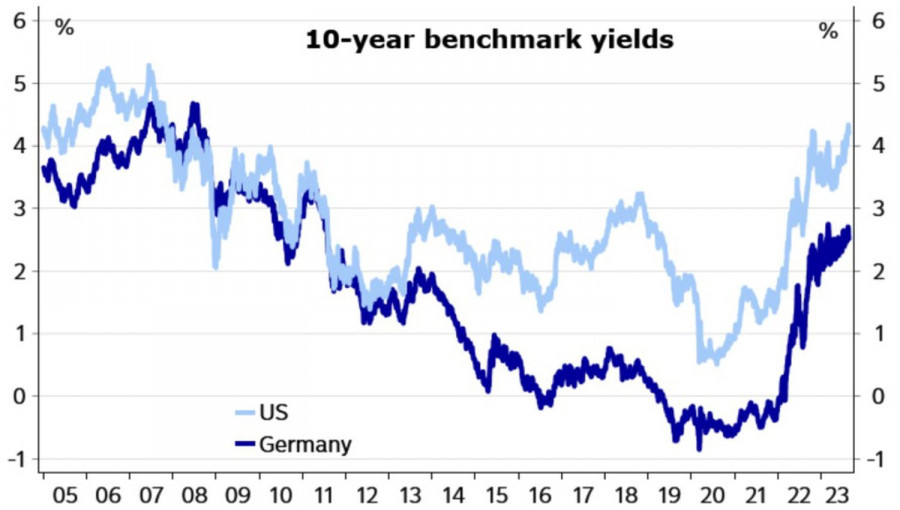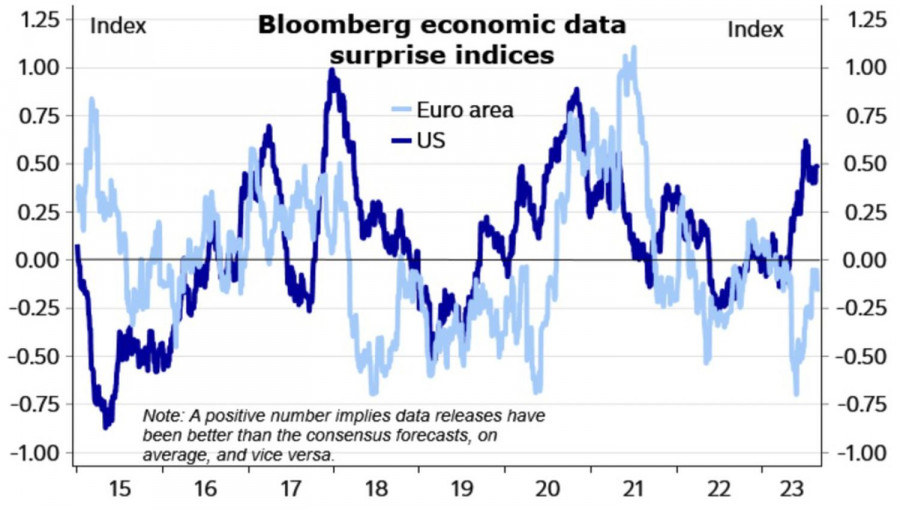Ten years ago at a meeting in Jackson Hole, then-IMF chief, Christine Lagarde, made a prophetic statement. She said the day would come when the era of exceptionally free monetary policy, both unconventional and traditional, would end. And now, that day has arrived. The global economy is reverting to an era of high interest rates. At the same time, Europe is much less ready for them than the US. This fact is at the heart of the EUR/USD peak.
The US economy is clearly stronger than the European economy. The US was much further away from the armed conflict in Ukraine than the eurozone. They did not feel the pain of the energy crisis, and more extensive fiscal stimuli allowed the US population to accumulate more excess savings. These became a sort of buffer against the Federal Reserve's monetary tightening. Lastly, the main pain point of the global economy is the manufacturing sector. Its share in the US is smaller than in countries like Germany.
Given this backdrop, it's no surprise that the yield on US bonds grew faster than their German counterparts. Its performance created a solid foundation for the EURUSD peak.
Dynamics of bond yields in the US and Germany

At the same time, investors are starting to doubt that the European Central Bank will raise the deposit rate by 25 bps to 4% in September. Even the head of the Bundesbank, Joachim Nagel, does not believe that inflation is under control, and the ECB needs to move further. Nonetheless, derivatives see the chances of continuing the monetary tightening cycle as fifty-fifty, and Nordea is confident that it has concluded, unlike the Fed's cycle.
A stronger economy makes inflation more resilient. I'm afraid the path of US consumer prices from 9% to 3% is easier than 3% to 2%. The Federal Reserve needs to keep raising rates to bring the Personal Consumption Expenditure index back to the 2% target. Once the markets realize this, EUR/USD will experience another wave of sell-offs.
Unlike the US, the eurozone economy has recently been more disappointing than encouraging lately. This was reflected in the decline of the economic surprises index. Its divergence from the American counterpart can be considered one of the drivers of the EUR/USD peak.
Dynamics of economic surprises of the US and the eurozone

What's next? Nordea believes the US will continue to outpace the currency bloc and expects the euro to fall to $1.07. This is likely to happen. However, a short-term EUR/USD rally is entirely possible. Bloomberg experts will be setting understated forecasts; the eurozone will surpass them, leading to an increase in the economic surprises index. A different picture will be observed in the US, but only temporarily. In conclusion, we should be selling the currency pair on the rise.
Technically, a lot will depend on the week's closing. If EUR/USD can close above the pivot level of 1.08, there's an increased risk of a pullback to the downtrend. This will be a reason for short-term long positions. On the contrary, falling below the key level will bring the previously mentioned targets of 1.071 and 1.066 for shorts closer.
The material has been provided by InstaForex Company - www.instaforex.comfrom Forex analysis review https://ift.tt/psU1Mex
via IFTTT
